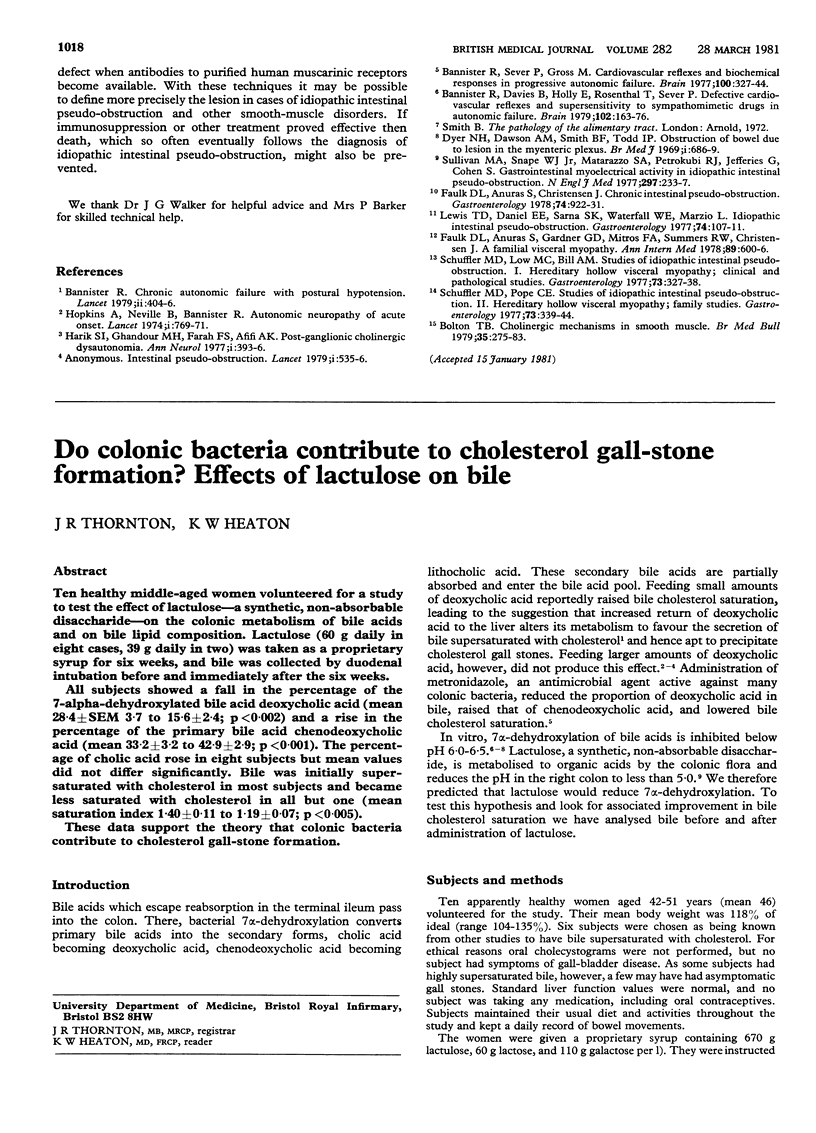Abstract
Ten healthy middle-aged women volunteered for a study to test the effect of lactulose--a synthetic, non-absorbable disaccharide--on the colonic metabolism of bile acids and on bile lipid composition. Lactulose (60 g daily in eight cases, 39 g daily in two) was taken as a proprietary syrup for six weeks, and bile was collected by duodenal intubation before and immediately after six weeks. All subjects showed a fall in the percentage of the 7-alpha-dehydroxylated bile acid deoxycholic acid (mean 28.4 +/- SEM 3.7 to 15.6 +/- 2.4; p less than 0.002) and a rise in the percentage of the primary bile acid chenodeoxycholic acid (mean 33.2 +/- 42.9 +/- 2.9; p less than 0.001). The percentage of cholic acid rose in eight subjects but mean values did not differ significantly. Bile was initially super-saturated with cholesterol in most subjects and became less saturated with cholesterol in all but one (mean saturation index 1.40 +/- 0.11 to 1.19 +/- 0.07; p less these 0.005). These data support the theory colonic bacteria contribute to cholesterol gall-stone formation.
Full text
PDF


Selected References
These references are in PubMed. This may not be the complete list of references from this article.
- Ahlberg J., Angelin B., Einarsson K., Hellstrom K., Leijd B. Influence of deoxycholic acid on biliary lipids in man. Clin Sci Mol Med. 1977 Sep;53(3):249–256. doi: 10.1042/cs0530249. [DOI] [PubMed] [Google Scholar]
- Andersen J. M. Chenodeoxycholic acid desaturates bile--but how? Gastroenterology. 1979 Nov;77(5):1146–1151. [PubMed] [Google Scholar]
- Aries V., Hill M. J. Degradation of steroids by intestinal bacteria. II. Enzymes catalysing the oxidoreduction of the 3 alpha-, 7 alpha- and 12 alpha-hydroxyl groups in cholic acid, and the dehydroxylation of the 7-hydroxyl group. Biochim Biophys Acta. 1970 May 5;202(3):535–543. doi: 10.1016/0005-2760(70)90124-4. [DOI] [PubMed] [Google Scholar]
- Bolton C. H., Low-Beer T. S., Pomare E. W., Wicks A. C., Yeates J., Heaton K. W. A simplified procedure for the analysis of cholesterol, phospholipids and bile salts in human bile. Clin Chim Acta. 1978 Feb 1;83(1-2):177–181. doi: 10.1016/0009-8981(78)90222-x. [DOI] [PubMed] [Google Scholar]
- Bown R. L., Gibson J. A., Sladen G. E., Hicks B., Dawson A. M. Effects of lactulose and other laxatives on ileal and colonic pH as measured by a radiotelemetry device. Gut. 1974 Dec;15(12):999–1004. doi: 10.1136/gut.15.12.999. [DOI] [PMC free article] [PubMed] [Google Scholar]
- Carulli N., Ponz de Leon M., Zironi F., Iori R., Loria P. Bile acid feeding and hepatic sterol metabolism: effect of deoxycholic acid. Gastroenterology. 1980 Oct;79(4):637–641. [PubMed] [Google Scholar]
- Cummings J. H., Hill M. J., Jenkins D. J., Pearson J. R., Wiggins H. S. Changes in fecal composition and colonic function due to cereal fiber. Am J Clin Nutr. 1976 Dec;29(12):1468–1473. doi: 10.1093/ajcn/29.12.1468. [DOI] [PubMed] [Google Scholar]
- Eastwood M. A., Hamilton D. Studies on the adsorption of bile salts to non-absorbed components of diet. Biochim Biophys Acta. 1968 Jan 10;152(1):165–173. doi: 10.1016/0005-2760(68)90018-0. [DOI] [PubMed] [Google Scholar]
- Hegardt F. G., Dam H. The solubility of cholesterol in aqueous solutions of bile salts and lecithin. Z Ernahrungswiss. 1971 Apr;10(3):223–233. doi: 10.1007/BF02020933. [DOI] [PubMed] [Google Scholar]
- Igimi H., Carey M. C. pH-Solubility relations of chenodeoxycholic and ursodeoxycholic acids: physical-chemical basis for dissimilar solution and membrane phenomena. J Lipid Res. 1980 Jan;21(1):72–90. [PubMed] [Google Scholar]
- LaRusso N. F., Szczepanik P. A., Hofmann A. F. Effect of deoxycholic acid ingestion on bile acid metabolism and biliary lipid secretion in normal subjects. Gastroenterology. 1977 Jan;72(1):132–140. [PubMed] [Google Scholar]
- Low-Beer T. S., Nutter S. Colonic bacterial activity, biliary cholesterol saturation, and pathogenesis of gallstones. Lancet. 1978 Nov 18;2(8099):1063–1065. doi: 10.1016/s0140-6736(78)91800-7. [DOI] [PubMed] [Google Scholar]
- Low-Beer T. S., Pomare E. W. Can colonic bacterial metabolites predispose to cholesterol gall stones? Br Med J. 1975 Feb 22;1(5955):438–440. doi: 10.1136/bmj.1.5955.438. [DOI] [PMC free article] [PubMed] [Google Scholar]
- Macdonald I. A., Singh G., Mahony D. E., Meier C. E. Effect of pH on bile salt degradation by mixed fecal cultures. Steroids. 1978 Sep;32(2):245–256. doi: 10.1016/0039-128x(78)90009-0. [DOI] [PubMed] [Google Scholar]
- Midtvedt T., Norman A. Parameters in 7-alpha-dehydroxylation of bile acids by anaerobic lactobacilli. Acta Pathol Microbiol Scand. 1968;72(2):313–329. doi: 10.1111/j.1699-0463.1968.tb01345.x. [DOI] [PubMed] [Google Scholar]
- Pomare E. W., Heaton K. W., Low-Beer T. S., Espiner H. J. The effect of wheat bran upon bile salt metabolism and upon the lipid composition of bile in gallstone patients. Am J Dig Dis. 1976 Jul;21(7):521–526. doi: 10.1007/BF01464757. [DOI] [PubMed] [Google Scholar]
- Pomare E. W., Low-Beer T. S. The selective inhibition of chenodeoxycholate synthesis by cholate metabolites in man. Clin Sci Mol Med. 1975 Apr;48(4):315–321. doi: 10.1042/cs0480315. [DOI] [PubMed] [Google Scholar]
- Vlahcevic Z. R., Bell C. C., Jr, Juttijudata P., Swell L. Bile-rich duodenal fluid as an indicator of biliary lipid composition and its applicability to detection of lithogenic bile. Am J Dig Dis. 1971 Sep;16(9):797–802. doi: 10.1007/BF02239307. [DOI] [PubMed] [Google Scholar]


